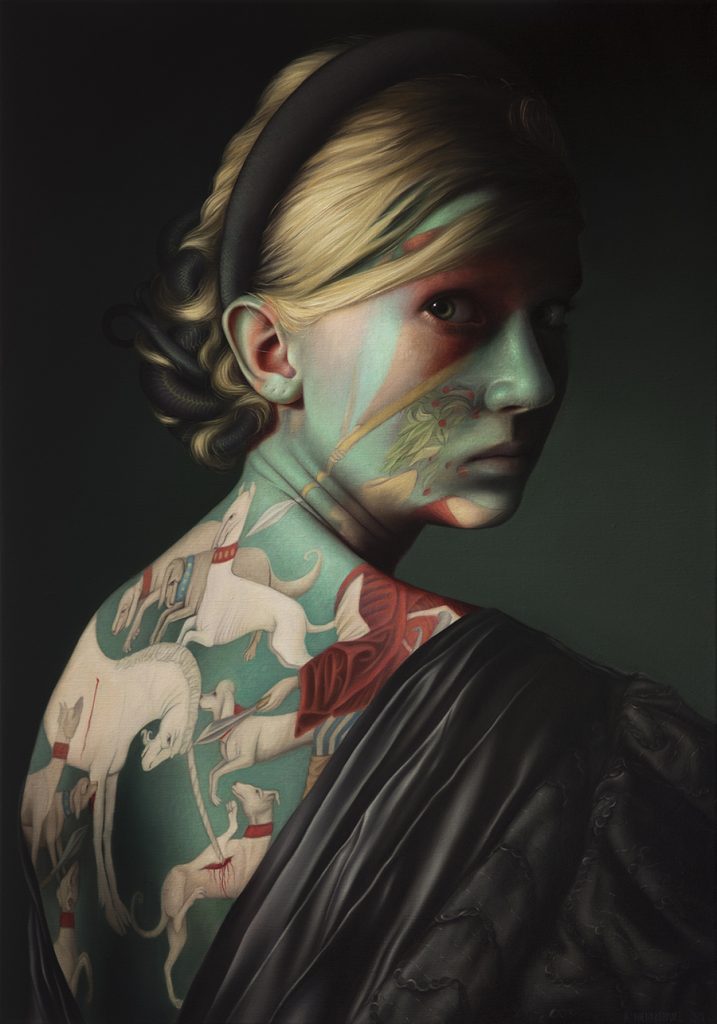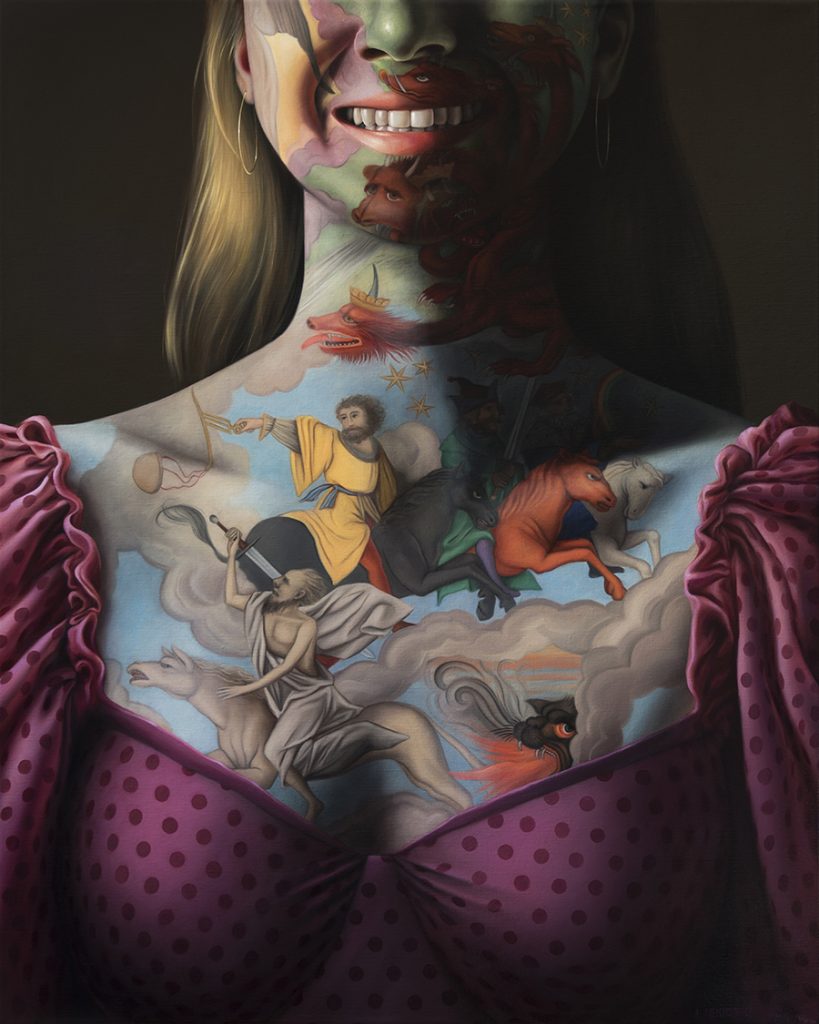Solo Exhibition by Agnieszka Nienartowicz
Longing for Another World
27.05.2022 - 02.07.2022
Please have a look at Art Lands viewing room to see all the paintings for the exhibition.
We are thrilled to present the exhibition Longing for Another World by the internationally renowned artist Agnieszka Nienartowicz (PL). Please join us for the vernissage May 27th 17:00-20:00 where we will serve bubbles and introduce you to the artist and her works.
Agnieszka Nienartowicz’s oil paintings lead us into a universe that points back to and re-actualizes the great master painters through art history by reproducing selected parts of their art works in a new context. Nienartowicz’s hyper-realistic oil paintings exude sensuality and mystery in a tranquil and intimate setting and her depiction of tattooed women provides a glimpse into a hidden world full of unsolved riddles and secret thoughts.
Nienartowicz’s individual exhibition Longing for Another World is a very personal and significant exhibition. It shows her formidable ability to grow as an artist and not to dwell on the successes of the past, but to develop and explore hitherto unknown areas within her artistic practice.
Among Nienartowicz’s ten new oil paintings for the exhibition, one will be able to recognize her characteristic motifs of women with tattoos on their bodies. In her earlier works, the women often appear with their backs to the viewer, but in Longing for Another World, faces have been turned head-on towards the viewer. A single grip that effectively changes the expression of the works significantly. Who are these women and what are their stories?
Some of Nenartowicz’s most recent works for the exhibition feature neither women nor tattoos. Here she shows a complete new and brave direction to her practice. Despite the different choice of motif the paintings maintain Nienartowicz’s characteristic moods, qualities, intensity, references to the past and techniques that brings goose bumps and wonderment to the viewer.
Please write to contact@pgallery.dk regarding the exhibition catalog.
A needlestick’s precision
The fascination with the female body throughout art history is evident. The desired female body, the body as home to motherhood, the body as the channel to nature are all perspectives on the multitude of depictions and ways of understanding of the female body. At a moment in a time when women, in many cases, are being liberated from stereotypical portrayals, where gender is determined neither biologically nor by anyone other than the persons themselves, Agnieszka Nienartowicz presents a striking feminine figure: she is elegant, graceful, and refined, stylishly wearing dresses made of silk, lace and fur with rich embroideries, tailor-made details and open backs. The hair is glowing healthily, well-groomed and either flowing pleasingly or set up in beautiful hairstyles. So attractive yet rarely exposed inasmuch as the women remain unidentified, while having their backs turned to us – a feature that has characterized most of Nienartowicz’s women up until this exhibition, where she has also presented their faces as well as pieces without women as the main characters.
Nienartowicz’s super realism is captivating and the use of claire-obscure comes across as a time travel back to the old masters. And then there are the tattoos: angels, skeletons, putti, Holy Mary, the Jesus child, and mythological figures have inhabited the women’s bodies and are depicted as giant tattoos covering most of the women’s backs, sometimes crawling up their necks and down their arms – transforming the women into odd messengers and marking the body as a rich place for many types of stories. We are familiar with tattoos found on bodies of people who lived more than 5,000 years ago. Decorating the body, applying symbols of meaning, status and belonging are well known rituals in many cultures running across continents: from the Ainu People of Japan to the Inuits and the women in ancient Egypt. But tattoos have also been used for the identification of criminals and have been used to systemize the handling of prisoners in Auschwitz. Why, meeting these contradictory women who are encircled by beauty and covered with these extensive and intense tattoos gets us to shudder.
The effort and dedication the women have undergone to make their bodies serve as a medium to these grand depictions pose a powerful metaphor about women’s bodies. The scenes are often dramatic and emotional, since they are referencing works by artists like Caravaggio, Peter Paul Rubens, Hieronymus Bosch, Pieter Bruegel the Elder and others. They are detailed, vivid and painted in the original colors – making them come to life on the soft and delicate female skin. Nienartowicz’s work is lucid and undiluted, but can also be gloomy when she gets it to tip towards the surreal. Pearl necklaces, broderie anglaise and blonde braids are put forward in such a realistic manner, almost making you reach out to feel whether this is really a painting or the real deal. But no – the naturalism is subtly punctuated when small leaves stick out from a tattoo and suddenly appear as though they were growing out from the ink underneath the skin, or when the snakes from Medusa’s hair swirl around the neck of the woman portrayed. Leaving you with your eyes wide open, your eyebrows elevated, and disorientated by the journey through art history across women’s skin, perforated by tattoo needles and fine strands of hair.
– Text by Art Historian, Natalia Gutman

Pilipczuk Gallery, Agnieszka Nienartowicz, The Unicorn Hunt, 2022, Oil on canvas, 100x70cm

